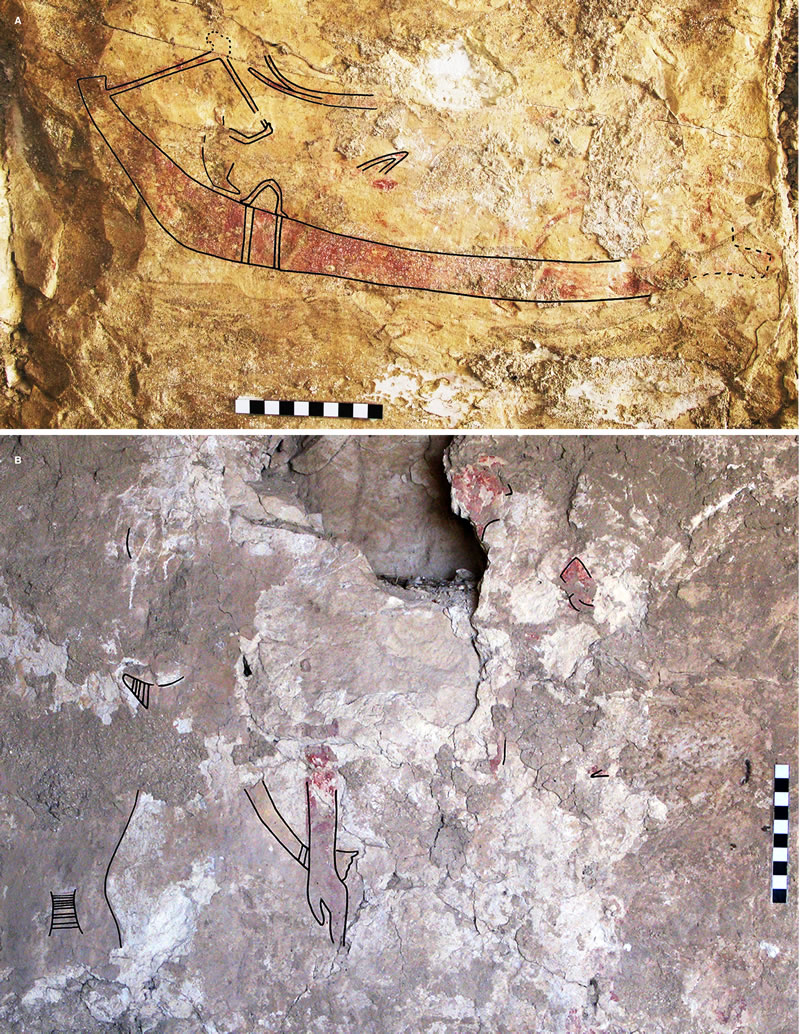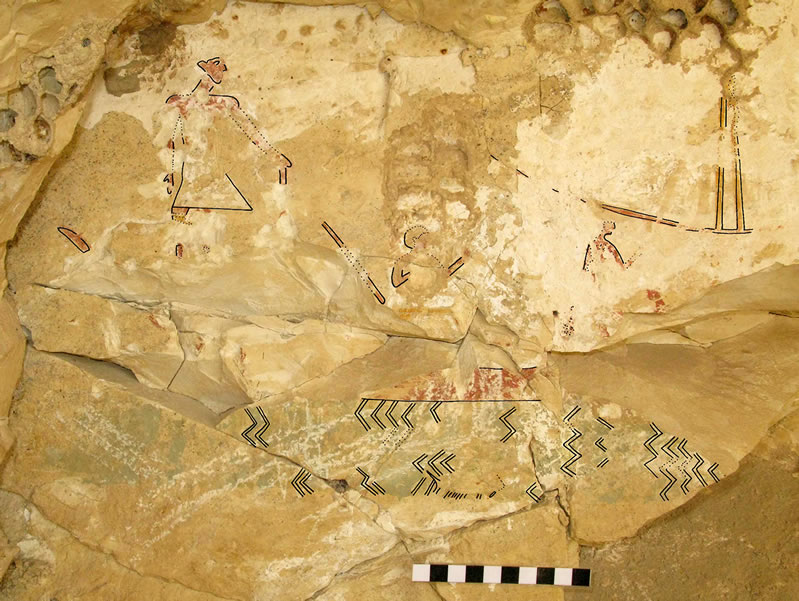Two Decorated Tombs of the First Intermediate Period: Area L
In the northernmost section of the Mo‘alla necropolis are two rock-cut tombs with traces of preserved painted decoration (M08-09/T1 and M08-09/T2). Except for the tombs of Ankhtyfy and Sobekhotep, these are the only known decorated tombs at the site and are thusfar unpublished.1
Although most of the painted plaster within the tombs is no longer extant, enough paint survives to reconstruct some of the scenes within the tombs and date the decoration to the First Intermediate Period, roughly contemporary with the tombs of Ankhtyfy and Sobekhotep.2

The north tomb, M08-09/T1, has fragmentary decoration remaining on the south and east walls of the tomb chapel. The south wall shows a boat — with the narrow hull, low profile, and raised stern of other First Intermediate period water craft3 sailing to the right; most of the figures or objects on board the ship are damaged, but traces of a man squatting at the steering oar are visible (Figure 1a).4 The south side of the east wall contains several registers of offering figures, including three men wearing short kilts, facing right, each presenting a different cut of meat;5 beneath the offering bearers the horns of a bull and the head of a human attendant, also facing right, are visible.6 On the north side of the east wall the tomb owner is depicted standing, while a female (probably his wife) stands behind him, grasping his left arm in her right hand; like the offering figures, the tomb owner and woman face to the right. In front of the tomb-owner is a smaller figure, facing left, who presents an offering (Figure 1b). Such “hovering” offering figures are a hallmark of First Intermediate Period art, and the preserved paint in M08-09/L.T1 suggests that the figure was presenting either a khepesh-leg or a jar held between his two hands.7 No texts are preserved, with the exception of a single hieroglyphic group:![]() ; the diagonal slanting lines of the third-h are an unusual feature that finds parallels from the Sixth through Thirteenth dynasties.8
; the diagonal slanting lines of the third-h are an unusual feature that finds parallels from the Sixth through Thirteenth dynasties.8

The decoration in M08-09/L.T2 has suffered even more severely than that of M08-09/L.T1 and only a single scene is still preserved. Within this scene two boats sail to the right over a waterway (Figure 2). Of the leftmost boat, part of the stern and a standing occupant — probably the tomb owner — are visible. The boat to the right is similarly fragmentary, but preserves traces of a bipartite mast and one curving yard-arm of the sail.9 A single red fish is preserved in the water, but no nets are visible.10
Notes
- 1. During our first field season, the MSP was able to make preliminary plans of the tombs and epigraphic copies of the decoration; additional work at these monuments will be a priority of future field seasons, so only a brief summary of the material is presented here.
- 2. The original publication of Vandier, Mo‘alla has admirable copies of the painting; for a stylistic commentary on Theban painting of the First Intermediate Period, with comparison to Gebelein and Mo‘alla, see Jaroš-Deckert, Das Grab des Jnj-jtj.f, Die Wandmalereien der XI. Dynastie (Mainz am Rhein, 1984).
- 3. B. Landström, Ships of the Pharaohs (New York, 1970), pp. 70-75; to his discussions of models, the painting cited in the next footnote should be added. Tombs of the late Sixth Dynasty depict boats with higher sterns and thicker hulls—compare M. Saleh, Three Old-Kingdom Tombs at Thebes (Mainz am Rhein, 1977), pl. 19 (tomb of Ihy, TT 186).
- 4. A man squatting at the stern controlling the steering oar is common in First Intermediate Period tombs—compare Jaroš-Deckert, Das Grab des Jnj-jtj.f, pl. 14, Ib2; Vandier, Mo‘alla, pl. XL, XLI; for early Middle Kingdom examples, see N. de G. Davies, Five Theban Tombs (London, 1913), pl. XXXVI (tomb of Dagi).
- 5. For similar scenes in First Intermediate Period tombs, compare the men wearing long kilts and bearing khepesh-legs in the tomb of Ankhtyfy (Vandier, Mo‘alla, p. 63 and pl. XXVIII; p. 69, fig. 25).
- 6. The decorative scheme of the east wall of the tomb M08-09/L.T1 probably resembled the west wall of the tomb of Meru at Naga ed-Deir (N3737, Ninth Dynasty): the tomb owner and his wife on the left side of the wall face two registers—offerings, including cuts of meat (replaced in M08-09/L.T1 by offering bearers with meat) above and the presentation of cattle below. See C.N. Peck, Some Decorated Tombs of the First Intermediate Period at Naga ed-Der (PhD Thesis, Brown University, 1958), pp. 110-112 and pl. XIII; whereas the tomb of Meru has a dwarf with gazelle and Meru’s son between the couple and the offerings, the Mo‘alla tomb M08-09.L.T1 has a hovering offering figure.
- 7. Parallel scenes include: tomb of Ankhtyfy, west wall, where a hovering figure presents a khepesh-leg to Ankhtyfy, who leans on a staff (Vandier, Mo‘alla, pl. XIV, XL); tomb of Iti (First Intermediate Period, Gebelein; A. M. Donadoni Roveri, E. D’Amicone, E. Leospo, Gebelein, Il villaggio e la necropoli [Turin, 1994], p. 50, fig. 56): Iti’s wife stands behind him, with her hand touching his waist, while her other arm grasps his shoulder, an offering figure hovering in front presents a khepesh-leg. For the jar held with both hands, compare the late Sixth Dynasty stela of the “inspector of the oasis” Idy (M. Vallogia, Les oasis d’Égypte dans l’Antiquité [Gollion, 2004], p. 145; idem., Le monument funéraire d’Ima-Pepy/Ima-Meryrê [Cairo, 1998], pp. 76-77) and the Sixth Dynasty stela of Qar (M. El-Khadragy, “The Edfu Offering Niche of Qar,” SAK 30 [2002]: 215 n. 41 [with other examples cited] and 216; references courtesy of John Darnell). An interesting variant of the “hovering” figure appears in two tombs at Naga ed-Deir ((N 359 and N 248), where the tomb owner sits before two registers of text and/or offerings; a man in the upper register stands on the baseline and offers a bowl to the face of the tomb owner (see Peck, Peck, Some Decorated Tombs of the First Intermediate Period, pp. 10, 69 and pls. 2, 5).
- 8. H. G. Fischer and R. Caminos, Ancient Egyptian Epigraphy and Palaeography (New York, 1976), p. 49, n. 78; note that the cursive hieroglyphic examples from a hes-vase in G. Brunton, Qau and Badari (London, 1927), vol. 1, pl. 41, ll. 6-7 are at the latest of Eleventh Dynasty date.
- 9. The bipartite mast is common in Old Kingdom scenes, but seems to disappear from the pictorial record by the time of the Middle Kingdom (D. Fabre, Le destin maritime de l’Égypte ancienne [London, 2004], pp. 114-115); the painting at Moalla may represent a rare—but not unexpected—survival of the bipod mast in the First Intermediate Period.
- 10. Fishing and fowling scenes of the First Intermediate Period can adhere to traditional Old Kingdom iconography or incorporate new, livelier images—see Jaroš-Deckert, Das Grab des Jnj-jtj.f, pp. 34-36; cf. also the Eleventh Dynasty tomb of Djar at Thebes (TT 366), which has lively scenes of fishing (H.E. Winlock, “The Museum’s Excavations at Thebes,” BMMA 27, No. 2, Part 2 (1932): 29, figs. 30 and 31; see also C. Roehrig, “The Early Middle Kingdom Cemeteries at Thebes and the Tomb of Djari,” in J. Assmann, et al., eds., Thebanische Beamtennekropolen [SAGA 12; Heidelberg, 1995], pp. 255-269).
